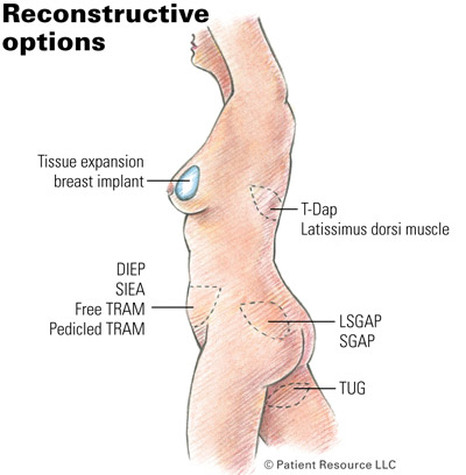Reconstruction using tissue from your tummy
SIEA Flap: The SIEA flap is named for the superficial inferior epigastric artery blood vessel that runs just under your skin in your lower abdomen. It’s also called a SIEP flap (superficial inferior epigastric perforator). It is very similar to a DIEP flap, except that a different section of blood vessels in the belly are moved with the fat and skin. Also, while a DIEP flap requires that a small incision be made in the layer that covers the rectus abdominis muscle, called the fascia, the SIEA flap doesn't require this incision.
SIEA Flap: The SIEA flap is named for the superficial inferior epigastric artery blood vessel that runs just under your skin in your lower abdomen. It’s also called a SIEP flap (superficial inferior epigastric perforator). It is very similar to a DIEP flap, except that a different section of blood vessels in the belly are moved with the fat and skin. Also, while a DIEP flap requires that a small incision be made in the layer that covers the rectus abdominis muscle, called the fascia, the SIEA flap doesn't require this incision.

Flap reconstruction using tissue from your thighs
TUG Flap: The transverse upper gracilis flap uses the gracilis muscle, located in the upper inner thigh. This muscle starts at your pubic bone and ends along the inside of your upper leg. The gracilis muscle helps you bring your leg toward your body. It’s important to know that with TUG flap surgery, you will no longer be able to use this muscle.
PAP Flap: PAP stands for profunda artery perforator. A PAP flap uses this blood vessel, as well as a section of skin and fat from the back of your upper thigh, to reconstruct the breast. Because no muscle is used, a PAP flap is considered a muscle-sparing type of flap.
Flap reconstruction using tissue from your buttocks
I-GAP flap: GAP stands for gluteal artery perforator, a blood vessel that runs through your buttocks. An IGAP flap uses the inferior gluteal artery perforator blood vessel, as well as a section of skin and fat from your lower buttocks — basically the lower section of the “butt cheek,” near the buttocks crease — to reconstruct the breast. Because no muscle is used, an IGAP flap is considered a muscle-sparing type of flap.
S-GAP flap : GAP stands for gluteal artery perforator, a blood vessel that runs through your buttocks. An SGAP flap (superior gluteal artery perforator), or gluteal perforator hip flap, uses this blood vessel, as well as a section of skin and fat from your upper buttocks/hip (the so-called “love handles”) to reconstruct the breast. Because no muscle is used, an SGAP flap is considered a muscle-sparing type of flap.
I-GAP flap: GAP stands for gluteal artery perforator, a blood vessel that runs through your buttocks. An IGAP flap uses the inferior gluteal artery perforator blood vessel, as well as a section of skin and fat from your lower buttocks — basically the lower section of the “butt cheek,” near the buttocks crease — to reconstruct the breast. Because no muscle is used, an IGAP flap is considered a muscle-sparing type of flap.
S-GAP flap : GAP stands for gluteal artery perforator, a blood vessel that runs through your buttocks. An SGAP flap (superior gluteal artery perforator), or gluteal perforator hip flap, uses this blood vessel, as well as a section of skin and fat from your upper buttocks/hip (the so-called “love handles”) to reconstruct the breast. Because no muscle is used, an SGAP flap is considered a muscle-sparing type of flap.
Reviewed by:
Dr Pouria Moradi
MBBS BSc (Med)
MRCS (Eng) FRACS (plas)
Source:
Adapted from breastcancer.org for the Australian experience
Dr Pouria Moradi
MBBS BSc (Med)
MRCS (Eng) FRACS (plas)
Source:
Adapted from breastcancer.org for the Australian experience






